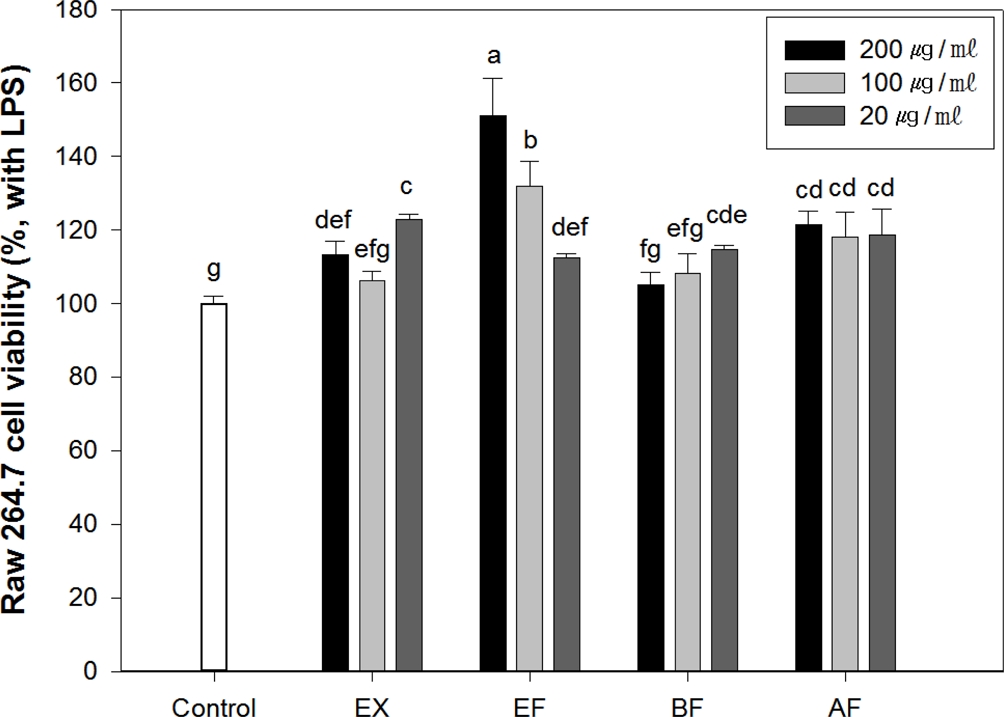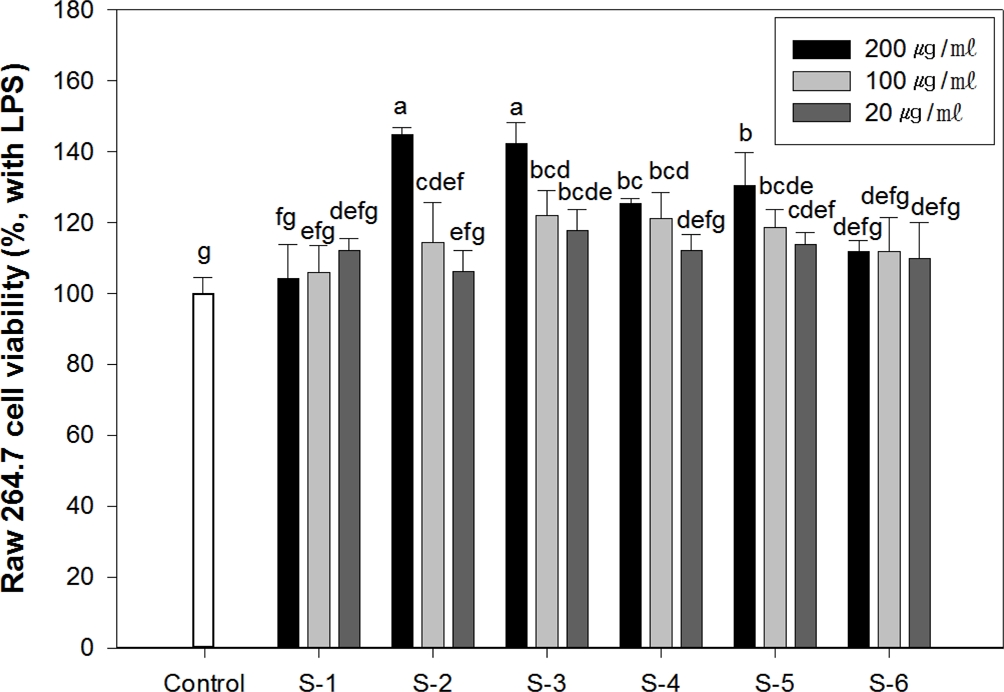
비파엽 열수 추출물에서 분리한 Caffeoylquinic Acid 3 종의 Nitric Oxide 생성 억제 효과
This is an open access article distributed under the terms of the Creative Commons Attribution Non-Commercial License (http://creativecommons.org/licenses/by-nc/3.0/) which permits unrestricted non-commercial use, distribution, and reproduction in any medium, provided the original work is properly cited.
Abstract
Research on hot water extracts of medicinal plants that are easily applicable in the clinical setting is essential. To confirm the anti-inflammatory-related active compounds present in the hot water extract of Eriobotrya japonica leaves, ability to inhibit nitric oxide (NO) production was measured and active compounds isolated from the extract were analyzed.
Sovent fractionation by solvent was performed to identify the active compounds present in the hot water extract, and the ability of the extract and the fractions obtained to inhibit NO production was measured. Subsequently, based on the results of liquid chromatography (LC) profile analysis of the n-butanol fraction that had a relatively high inhibitory ability of NO production, six subfractions were separated around the main peak. Among the separated subfractions spectra from mass spectroscopy (MS) were analyzed and standard comparisons were performed on the compounds of the three main peaks on the chromatogram. NO production inhibitory activity of subfraction 2 identified as neochlorogenic acid was the highest with an IC50 of 18.49 ㎍/㎖ followed by that of subfraction 5 identified as cryptochlorogenic acid with IC50 of 25.82 ㎍/㎖.
Our result, it was confirmed that several caffeoylquinic acids, including neochlorogenic acid and cryptochlorogenic acid present in the hot water extract of E. japonica leaves have an important role as compounds exhibiting anti-inflammatory activity.
Keywords:
Eriobotrya japonica, Caffeoylquinic Acid, Nitric Oxide, Liquid Chromatography-mass Spectroscopy서 언
최근 사회가 현대화 및 도시화 되면서 환경오염, 식생활의 변화, 과도한 스트레스 등에 의해 다양한 연령층에서 염증질환의 발생이 크게 증가하고 있으며, 염증질환에 대한 원인 규명과 약물 개발이 지속적으로 진행되고 있다 (Lee et al., 2017b).
대표적인 염증 질환으로는 알레르기 및 아토피, 류마티스 관절염 등이 있고, 염증반응에 관여하는 대표적인 세포로는 대식세포가 있다. 대식세포는 선천면역과 적응면역 등 다양한 면역반응에 관여하는 세포로, lipopolysaccharide (LPS), interferon-gamma (IFN-γ), tumor necrosis factor-alpha (TNF-α)와 같은 자극으로 인해 과도하게 활성화된다 (Yoon et al., 2014).
활성화된 대식세포는 nitric oxide (NO), prostaglandin E2 (PGE2)와 같은 전염증 매개체 (proinflammatory mediators), 사이토카인 (cytokine), 활성 산소종 (reactive oxygen species, ROS) 등이 분비되어 세포내 독성을 야기한다 (Miyataka et al., 2002; Lee et al., 2019). NO는 생리적인 현상인 혈압조절, 신경전달 매개체로서의 작용, 혈액응고, 면역기능 등의 역할을 하는 것으로 알려져 있다 (Kang et al., 2013). 하지만 과량 생성 시 조직손상을 유발하고, 염증반응을 일으켜 prostaglandin과 같은 염증 매개체의 생합성을 촉진하여 염증을 심화시킨다 (Cho and Choi, 2011). 그러므로 LPS 등의 유해인자에 의하여 증가되는 NO의 생성을 억제시키는 수준을 측정하는 방법은 항염증 활성 관련 약물의 기본적인 연구방법 중의 하나로 활용되고 있다.
비파엽은 우리나라를 포함한 아시아 지역에 주로 분포하고 있는 장미과 (Rosaceae)에 속하는 비파나무 (Eriobotrya japonica L.)의 잎을 가공한 것으로서 부종, 기관지염, 청폐, 진해, 거담, 건위, 이뇨, 갈증, 구토 등에 효능이 뛰어나다고 기록되어 있으며, 염증이나 종양 등의 치료에 주로 사용되기도 한다 (Bae et al., 1998; Kim and Kim, 2013; Lee et al., 2017a). 비파엽의 생리활성에 관한 연구로서 항산화활성, 항돌연변이 효과, 항암효과 등이 보고되었으며, 항염증 활성 관련 연구도 다수 이루어졌다 (Whang et al., 1996; Bae et al., 2002; Huang et al., 2007; Hwang et al., 2010; Cha et al., 2011; Park et al., 2015). 이러한 연구들에서는 주로 활성 성분의 추출이 용이한 methanol 등 유기용매를 활용한 연구가 대부분이며, 최근 들어 비파엽의 열수 추출물의 항염증 관련 활성 연구가 일부 있었으나 (Kim et al., 2020) 추출물 자체의 효과만을 대상으로 하여 활성 성분에 대한 분석 연구가 병행될 필요가 지속적으로 제기되고 있다.
본 연구에서는 약용 식물의 일반적인 활용에 있어서 빈번히 사용되고 있는 열수추출 방법을 적용하여 제조된 비파엽 추출물의 염증 관련 활성 성분에 대한 탐색을 위해 열수추출물과 용매별 분획물에 대한 NO 생성억제 활성을 확인하고 고활성 분획물 중의 주요 성분을 분리하여 해당 성분에 대한 분석을 실시하였다.
재료 및 방법
1. 실험재료
본 실험에 사용한 비파엽은 화림제약에서 건조된 것을 구입하여 사용하였으며, 분쇄한 비파엽 300 g에 증류수 6ℓ를 가하여 100℃에서 2 시간, 2 회 반복하여 환류추출을 실시하였다. 추출액은 여과 후 동결건조하여 30.9 g의 열수추출물을 얻었으며, 냉장 보관하면서 실험에 사용하였다.
증류수에 분산시킨 비파엽 열수추출물에 순차적으로 ethylacetate, n-butanol을 혼합하여 용매별 분획을 실시한 후 여과와 감압농축 및 동결건조를 거쳐 ethylacetate, n-butanol, aqueous 분획물을 각각 4.99%, 5.86%, 89.15% 비율로 얻었으며, 냉장보관하면서 실험에 사용하였다.
2. 기기 및 시약
분석용 LC는 UV 검출기인 SPD-20A를 장착한 Shimadzu 사 (Kyoto, Japan)의 LC-30A를 사용하였으며, 질량분석기는 Shimadzu사 (Kyoto, Japan)의 LCMS-8050 triple quadrupole mass spectroscopy (MS)를 사용하였다. 활성 성분 분리를 위한 LC는 SPD-10Avp UV 검출기를 장착한 Shimadzu사 (Kyoto, Japan)의 LC-20A를 사용하였으며, nitric oxide 생성 억제 활성과 세포생존률 측정에는 Bio-Tek Instruments사 (Winooski, VT, USA)의 PowerWave X340 microplate reader를 사용하였다. 기기분석에 필요한 용매는 J.T. Baker (Phillipsburg, NJ, USA) 제품을 사용하였으며, lipopolysaccharide (LPS)와 Griess reagent, 분석용 표준품인 3-O-caffeoylquinic acid (chlorogenic acid), 4-O-caffeoylquinic acid (cryptochlorogenic acid), 5-O-caffeoylquinic acid (neochlorogenic acid)는 Sigma-Aldrich (St. Louis, MO, USA) 제품을 사용하였다.
3. Nitric oxide 생성억제 활성 측정
시료의 nitric oxide (NO) 생성억제 활성을 측정하기 위하여 미리 배양된 Raw264.7 세포를 96 well plate에 5 × 104 cells/well이 되도록 분주하여 24 시간 동안 배양한 후, 각 시료를 4㎍/㎖ - 200㎍/㎖의 농도로 처리한 후 lipopolysaccharide (LPS, 2㎍/㎖)를 혼합하여 24 시간 동안 추가로 배양하였다.
배지 상등액을 100 ㎕ 취하여 Griess reagent 100 ㎕와 상온에서 15 분간 반응시킨 다음 microplate reader를 이용하여 540㎚에서 흡광도를 측정하였다 (Ding et al., 1988). 시료 대신 PBS를 처리한 대조구의 흡광도를 기준으로 시료별 NO 생성억제 활성을 산출하였다.
4. 세포생존율 측정
비파엽 추출물 및 분획물이 Raw264.7 세포에 미치는 세포 독성을 3-(4,5-dimethylthiazol-2-yl)-2,5-diphenyltetra zolium bromide (MTT) assay로 확인하였다 (Shin et al., 2003). NO 생성억제 활성 측정을 위해 실시된 세포 배양이 완료된 후 2.5 ㎎/㎖ 농도의 MTT 용액을 각 well에 20 ㎕씩 첨가하여 37℃에서 3 시간 반응시킨 다음 배지를 제거하고 dimethylsulfoxide를 100 ㎕ 첨가하여 formazan 결정을 용해시킨 후 540 ㎚에서 microplate reader로 흡광도를 측정하였다. 시료 대신 PBS로 처리한 대조구의 흡광도를 기준으로 시료별 세포생존율을 산출하였다.
5. NO 생성 억제 활성 성분의 LC-MS/MS 분석
활성 성분의 LC 분석에 사용된 이동상 용매는 water (0.1% formic acid, A) 및 acetonitrile (B)의 혼합액을 이용하였으며, 용매의 농도 구배는 0 분 - 3 분 (0%, B), 3 분 - 50 분 (0% → 10%, B), 50 분 - 57 분 (10% → 100%, B)으로 설정하여 0.2 ㎖/min 유속으로 실시하였다. 검출기의 파장은 254 ㎚와 320 ㎚로 설정하여 검출 성분의 특성 검토에 활용하였다. 시료 및 표준품은 70% 메탄올 용액에 녹여 분석하였으며, 1 ㎎/㎖ 농도로 조제된 시료 및 표준품 2 ㎕를 주입하여 분석을 수행하였다. 분석용 column으로 Kinetex C18 (2.1 ㎜ × 150 ㎜, 2.6 ㎛, Phenomenex Inc., Torrance, CA, USA)을 사용하였으며, oven 온도는 40℃로 설정하였다.
분리된 성분 및 표준품의 분자량 검토를 위한 LC-MS/MS 분석은 LC 분석과 동일한 이동상 및 column 조건을 적용하여 실시하였으며, scan mode 분석을 위한 세부 조건은 Table 1과 같이 설정하였다.
6. LC 분리 조건
활성 분획물에 대한 성분 분리를 위한 LC 분리에 사용된 이동상 용매는 LC-MS/MS 분석과 동일하게 water (0.1% formic acid, A) 및 acetonitrile (B)의 혼합액을 이용하였으며, LC 분석 결과를 바탕으로 유사한 분리 패턴을 가질 수 있도록 용매의 농도 구배를 0 분 - 5 분 (0%, B), 5 분 - 50 분 (0% → 10%, B), 50 분 - 52 분 (10% → 100%, B)으로 설정하여 2.5 ㎖/min 유속으로 실시하였다. 검출기의 파장은 320 ㎚로 설정하였으며, 200 ㎎/㎖ 농도로 조제된 분획물 시료 50 ㎕를 주입하여 분리를 수행하였다. 분리용 ODS-A (5 ㎛, YMC Co., Ltd., Kyoto, Japan)를 충전한 column (4.6 ㎜ × 300 ㎜)을 사용하였으며, oven 온도는 40℃로 설정하였다.
7. 통계분석
측정값은 3 회 이상 반복 실험한 결과의 평균값과 표준편차 (mean ± SD)로 표시하였고, 각 실험군 간의 통계학적 분석은 windows용 SPSS 12.0 (SPSS Inc., Chicago, IL, USA)을 이용하였다. 각 군 간의 측정치 비교는 One-way analysis of variance (ANOVA)를 시행한 후 사후분석으로 Duncan's Multiple Range Test (DMRT)를 실시하여 5% 수준에서 유의성이 있는 것으로 판단하였다 (p < 0.05).
결과 및 고찰
1. 비파엽 열수추출물 및 분획물의 Nitric oxide 생성억제 활성
Nitric oxide (NO)는 생체 내에서 합성 효소에 의해 L-arginine으로부터 생성되는 free radical로 염증반응의 매개체로 시간이 지나면 nitrite, nitrate 등의 안정한 화합물로 존재하며, 이 과정에서 형성되는 peroxynitrite anion으로 인해 혈관투과성, 부종 등의 염증반응을 촉진시킬 뿐 아니라 cyclooxygenase를 활성화하여 prostaglandin과 같은 염증 매개체의 생합성을 촉진함으로써 염증을 심화시키는 것으로 알려져 있다 (Kang et al., 2013; Rang, 2013).
본 연구에서는 비파엽 열수추출물 및 용매별 분획물의 항염증 관련 활성을 확인하기 위해 각 시료를 농도별로 처리한 후 lipopolysaccharide (LPS)를 이용하여 Raw264.7 세포에 염증 반응을 유발시켜 시료의 NO 생성억제 수준을 측정하였다. Table 2에 나타난 결과와 같이 비파엽 열수추출물에서는 실험이 실시된 농도에서 확인할 수 없었던 NO 생성억제 활성이 n-butanol과 ethylacetate 분획에서 50%의 NO 생성억제에 필요한 시료 농도인 IC50 수준이 각각 97.83㎍/㎖, 110.62㎍/㎖로 나타났다.

Nitric oxide production inhibitory abilities of hot water extract of E. japonica leaves and its fractions.
이와 같은 NO 생성억제 활성이 Raw264.7 세포 자체의 증식을 억제하여 나타난 영향에 의한 것인지 확인하기 위해 동일한 배양 조건에서의 세포생존율을 MTT assay로 측정하여 Fig. 1에 제시하였다. 실험이 실시된 농도 범위에서 각 시료의 세포생존율이 105.2% - 150.9% 수준으로 나타남에 따라 세포 증식 자체가 억제되어 NO 생성량이 감소된 것이 아님을 확인할 수 있었다.
2. n-Butanol 분획물의 주요 활성 성분 분리
용매별 분획물에 대한 NO 생성억제 활성 측정에서 가장 높은 활성을 가지는 것으로 나타난 n-butanol 분획물에 대한 LC profile 분석에서 Fig. 2와 같은 패턴을 나타냄에 따라 254 ㎚와 320 ㎚의 파장에서 모두 높은 감도를 나타낸 peak를 중심으로 chromatogram에 표시된 머무름 시간 영역과 같이 6 가지로 분리를 실시하였다.

LC profile of n-butanol fraction of hot water extract of E. japonica leaves.1 - 6; subfraction numbers separated by retention time range of major peaks. Two different wavelengths (254 and 320 ㎚) were used to confirm the identity of each compound peak.
각 영역의 분리물들을 subfraction 1 - subfraction 6으로 구분하여 반복해서 회수한 후 농축과 동결건조를 실시한 후 최종적으로 고형분 형태로 얻었으며, 순서대로 27.52%, 3.64%, 6.61%, 10.04%, 7.29%, 44.90%의 수율을 확인하였다.
3. n-Butanol 분획물에서 분리한 성분의 Nitric oxide 생성억제 활성
비파엽 추출물 중에 존재하는 NO 생성억제 활성 성분을 확인하기 위해 n-butanol 분획물에서 분리한 subfraction 1 - subfraction 6의 NO 생성억제 활성을 추가로 측정하였다. Table 3에 제시한 결과와 같이 n-butanol 분획물에서 분리한 subfraction에 대한 NO 생성억제 활성 측정에서 subfraction 2가 18.49 ㎍/㎖의 IC50으로 가장 높은 NO 생성억제 활성을 가지는 것으로 나타났다. 다음으로 subfraction 5의 IC50이 25.82 ㎍/㎖로 나타났으며, subfraction 1,3, 4,6 은 상대적으로 NO 생성억제 활성이 낮은 것을 확인할 수 있었다.

Nitric oxide production inhibitory abilities of isolated subfractions from n-butanol fraction of hot water extract of E. japonica leaves.
추출물 및 용매별 분획물 NO 생성억제 활성 측정의 경우와 마찬가지로 동일한 배양 조건에서의 세포생존율을 측정한 결과를 Fig. 2에 제시하였다. 실험이 실시된 농도 범위에서 각 시료의 세포생존율이 104.3% - 144.9% 수준으로 나타났으며, 세포독성에 의한 NO 생성억제의 영향은 없는 것으로 판단하였다.
4. n-Butanol 분획물에서 분리한 성분의 LC-MS 분석
분리된 subfraction 중 LC profile 분석 결과에서 해당 peak의 순도가 90% 이상으로서 단일 peak로 추정되며, NO 생성억제 활성이 n-butanol 분획물보다 높은 것으로 나타난 subfraction 2, 4, 5 시료의 성분 확인을 위해 LC-MS 분석을 실시하였다.
Fig. 4에 제시된 subfraction 2의 주성분인 retention time 23.04 분 peak의 MS spectra을 보면 negative mode에서 [M-H]- 형태로 볼 수 있는 353.10 m/z와 positive mode에서 [M+H]+와 [M+Na]+ 형태로 볼 수 있는 355.10와 377.10 m/z가 확인됨에 따라 모분자량이 354인 성분으로 추정할 수 있었다. 이와 같은 MS spectra는 기존의 문헌을 참고하여 caffeoylquinic acid 계열의 성분에서 나타나는 전형적인 형태임을 알 수 있었다 (Bajko et al., 2016).
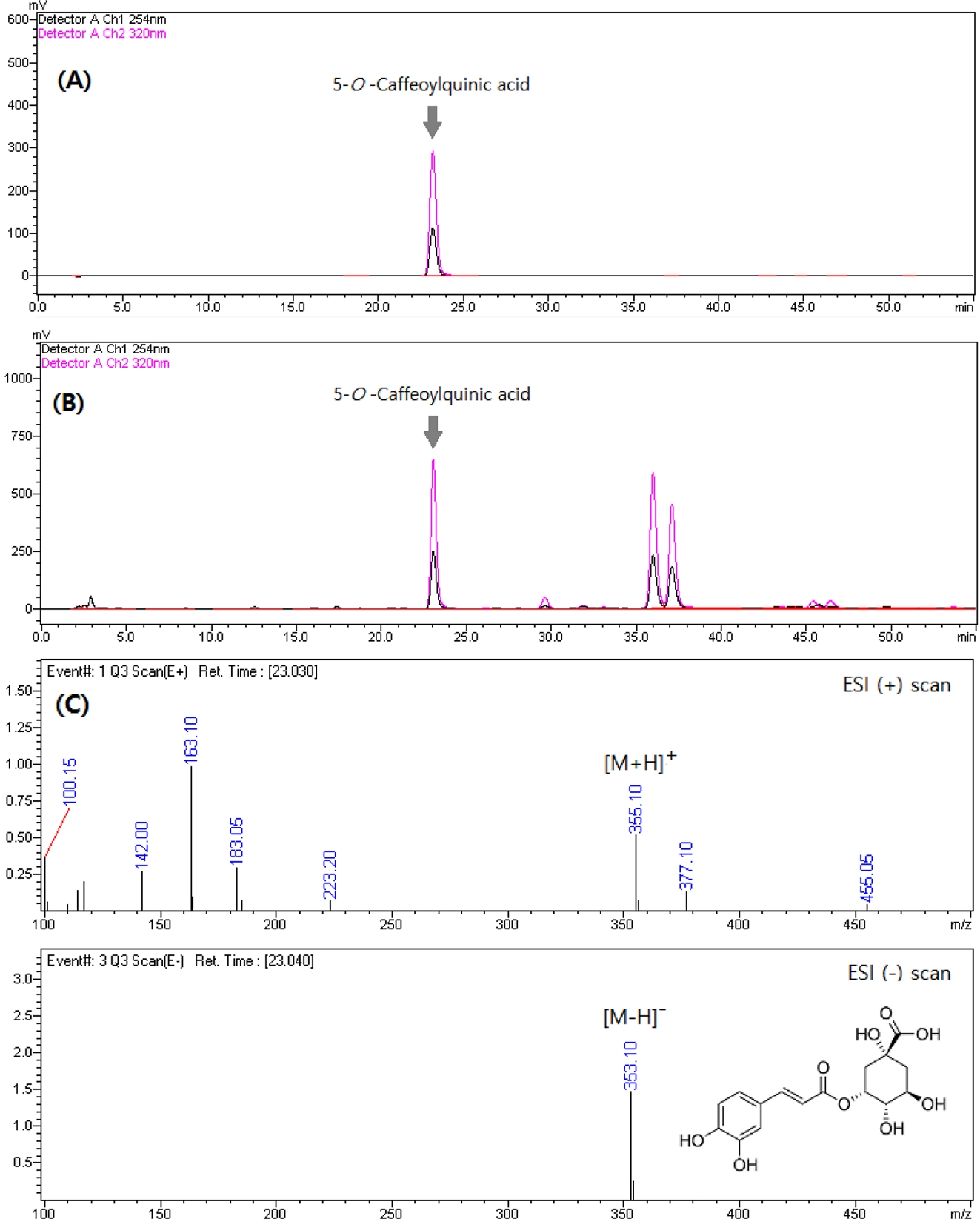
LC chromatograms and MS spectra of 5-O-caffeoylquinic acid and n-butanol fraction of hot water extract of E. japonica leaves.(A); 5-O-caffeoylquinic acid standard, (B); n-butanol fraction of hot water extract of E. japonica leaves, (C); LC-MS spectra of 5-O-caffeoylquinic acid and subfraction 2.
Fig. 5와 Fig. 6에 제시한 subfraction 4와 subfraction 5의 주성분인 retention time 35.82 분과 36.97 분 peak의 MS spectra에서도 subfraction 2의 주성분 peak와 동일한 패턴의 MS spectra를 나타냄에 따라 caffeoylquinic acid 계열의 성분임을 추정할 수 있었다. Caffeoylquinic acid 계열에서 일반적으로 나타날 수 있는 화학구조와 기존 연구 보고를 검토하여 3-O-, 4-O-, 5-O- 위치에 caffeoyl기를 포함하는 caffeoylquinic acid임을 추정하였으며, 해당 성분의 표준품을 확보한 후 분석 결과를 검토한 결과, subfraction 2, 4, 5의 주요 peak가 각각 5-O-caffeoylquinic acid (neochlorogenic acid), 3-O-caffeoylquinic acid (chlorogenic acid), 4-O-caffeoylquinic acid (cryptochlorogenic acid) 임을 확인하였다 (Zhang et al., 2015).
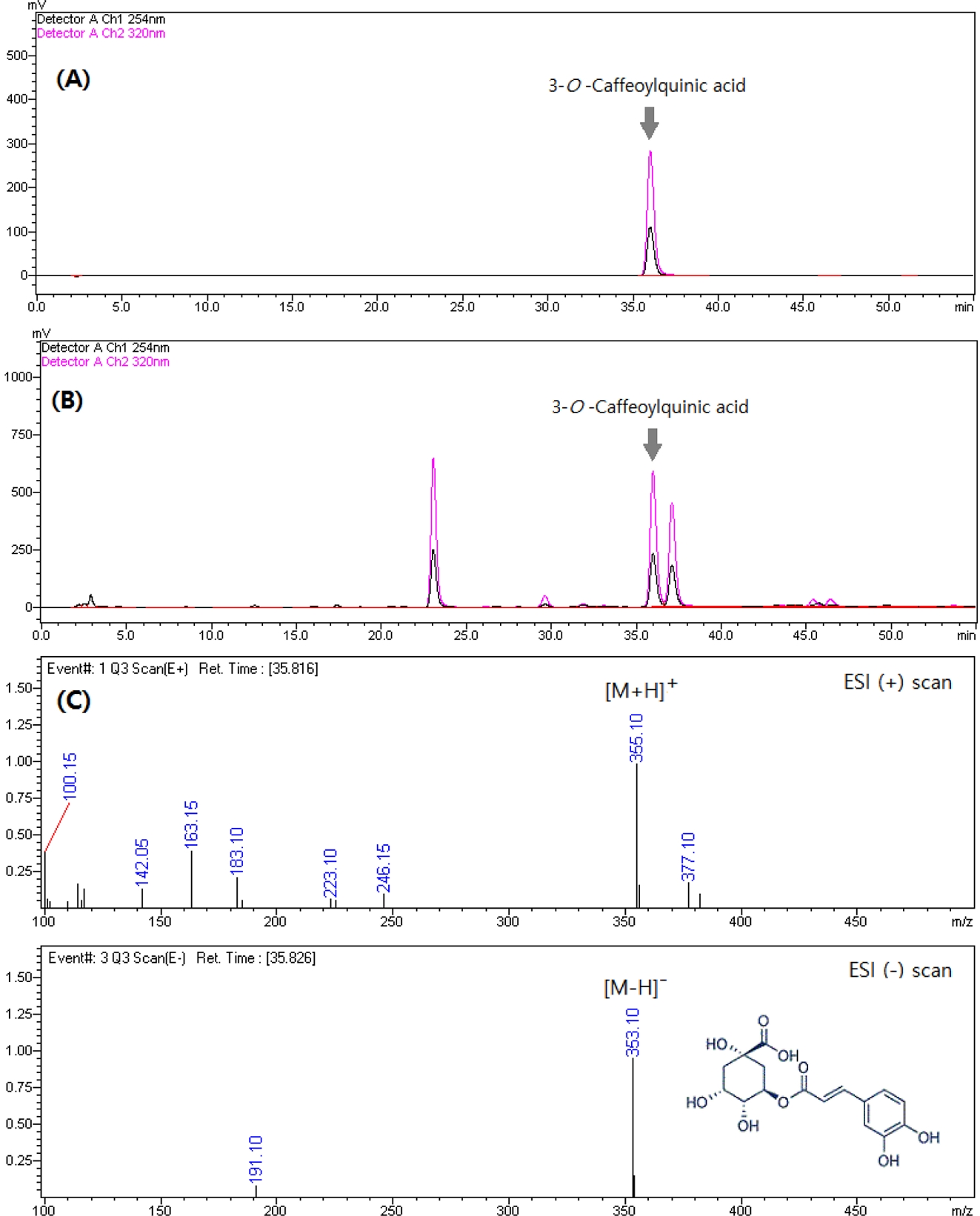
LC chromatograms and MS spectra of 3-O-caffeoylquinic acid and n-butanol fraction of hot water extract of E. japonica leaves.(A); 3-O-caffeoylquinic acid standard, (B); n-butanol fraction of hot water extract of E. japonica leaves, (C); LC-MS spectra of 3-O-caffeoylquinic acid and subfraction 4.
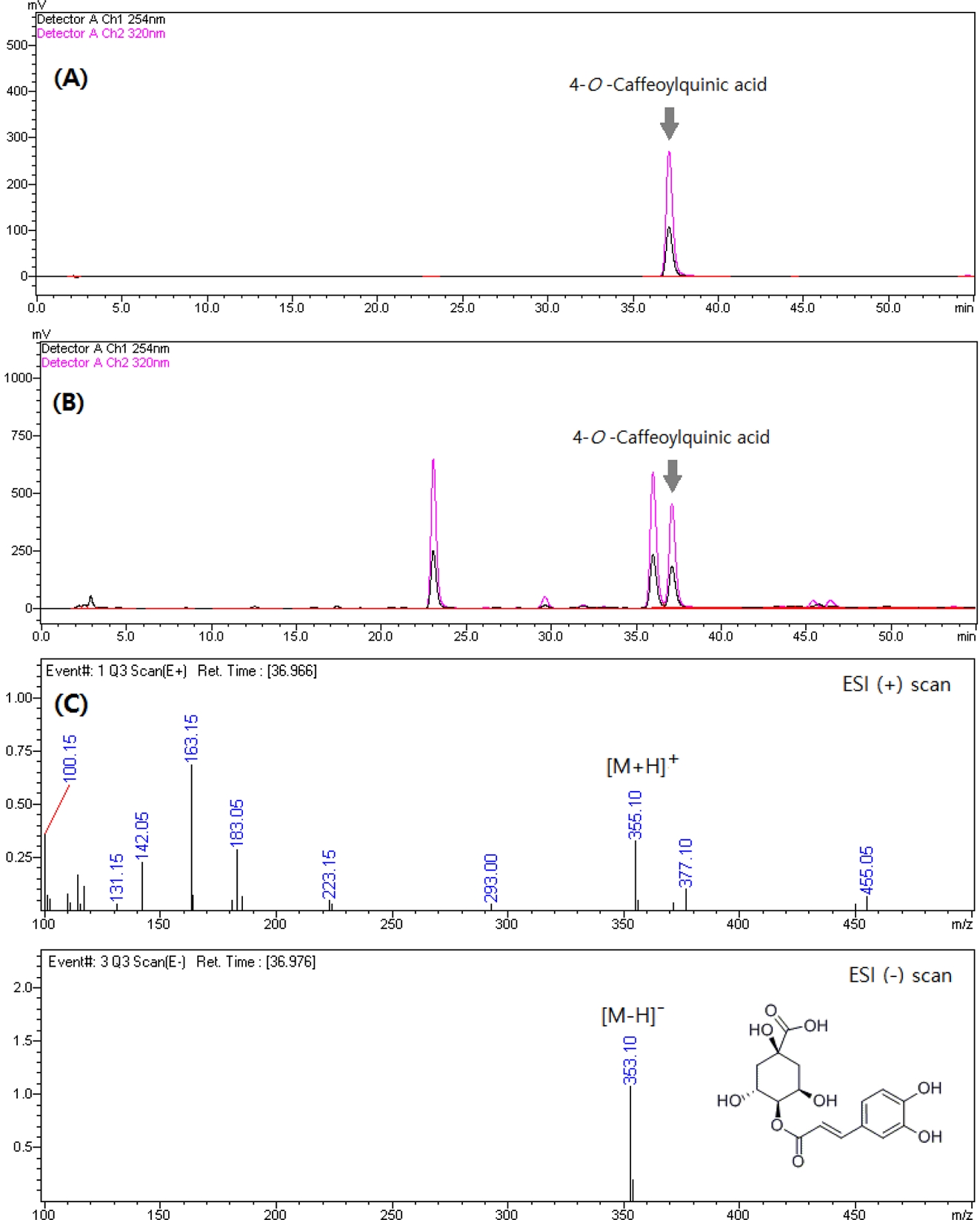
LC chromatograms and MS spectra of 4-O-caffeoylquinic acid and n-butanol fraction of hot water extract of E. japonica leaves.(A); 4-O-caffeoylquinic acid standard, (B); n-butanol fraction of hot water extract of E. japonica leaves, (C); LC-MS spectra of 4-O-caffeoylquinic acid and subfraction 5.
NO 생성억제 활성에서 가장 높은 활성을 가지는 것으로 나타난 subfraction 2의 5-O-caffeoylquinic acid는 기존 연구에서 항염증 관련 활성이 일정 수준 이상 나타나는 것으로 보고하고 있다 (Kim et al., 2015; Gao et al., 2020). 한편 subfraction 5의 4-O-caffeoylquinic acid가 기본적으로 항염증 활성을 가지는 것으로 알려진 subfraction 4의 3-O-caffeoylquinic acid의 활성보다 높으며 (Kim et al., 2017), 5-O-caffeoylquinic acid의 활성보다는 다소 낮은 수준의 NO 생성 억제 활성을 가지는 것으로 확인되었다. 이와 같은 결과와 함께 subfraction 2와 subfraction 5가 분획물에서 차지하는 비율이 각각 3.64%, 7.29%임을 감안하면 비파엽 열수추출물의 항염증 관련 활성에서 4-O-caffeoylquinic acid가 5-O-caffeoylquinic acid보다 높은 기여도를 가질 것으로 판단된다.
비파엽 열수추출물에 존재하는 항염증 관련 활성 성분을 확인하기 위해 추출물 및 용매별 분획물에 대한 NO 생성억제 활성을 측정한 후 상대적으로 NO 생성억제 활성이 높은 n-butanol 분획물의 LC profile 분석 결과를 바탕으로 주요 peak를 중심으로 6 개의 subfraction을 분리하였다.
분리한 subfraction 중 chromatogram 상에서 나타난 3개의 주요 peak의 성분이 MS spectra와 표준품 비교 분석을 통해 3-O-, 4-O-, 5-O- 위치에 caffeoyl기를 포함하는 caffeoylquinic acid임을 확인하였다. 이 세 가지 성분 중 5-O-caffeoylquinic acid (neochlorogenic acid)로 확인된 subfraction 2의 NO 생성억제 활성이 18.49 ㎍/㎖의 IC50으로 가장 높았으며, 4-O-caffeoylquinic acid (cryptochlorogenic acid)로 확인된 subfraction 5의 IC50이 25.82 ㎍/㎖로 다음으로 높은 활성을 나타냈다. 한편 3-O-caffeoylquinic acid (chlorogenic acid)로 확인된 subfraction 4는 상대적으로 NO 생성억제 활성이 낮은 것을 확인할 수 있었으며, subfraction 3에서 나타난 NO 생성억제 활성과 같이 caffeoylquinic acid 계열 성분 이외의 NO 생성억제 활성 성분의 존재 가능성이 확인됨에 따라 이와 관련된 추가적인 연구가 필요할 것으로 판단되었다.
Acknowledgments
본 연구는 2017년도 동신대학교 연구년교수 연구비(국책사업 지원)에 의하여 이루어진 결과로 이에 감사드립니다.
References
- Bae YI, Jeong CH and Shim KH. (2002). Nitrite-scavenging and antimutagenic effects of various solvent extract from different parts of loquat(Eriobotrya japonica Lindl.). Korean Journal of Food Preservation. 9:92-96.
- Bae YI, Seo KI, Park SK and Shim KH. (1998). Loquat (Eriobotrya japonica Lindl.) leaf tea processing and its physicochemical properties. Korean Journal of Postharvest Science and Technology. 5:262-269.
-
Bajko E, Kalinowska M, Borowski P, Siergiejczyk L and Lewandowski W. (2016). 5-O-caffeoylquinic acid: A spectroscopic study and biological screening for antimicrobial activity. LWT-Food Science and Technology. 65:471-479.
[https://doi.org/10.1016/j.lwt.2015.08.024]

-
Cha DS, Eun JS and Jeon H. (2011). Anti-inflammatory and antinociceptive properties of the leaves of Eriobotrya japonica. Journal of Ethnopharmacology. 134:305-312.
[https://doi.org/10.1016/j.jep.2010.12.017]

-
Cho EK and Choi YJ. (2011). Antioxidant and anti-inflammatory activities of extracts of traditional medicinal plants mixtures 1 and 2. Journal of Life Science. 21:596-603.
[https://doi.org/10.5352/JLS.2011.21.4.596]

- Ding A, Nathan CF and Stuehr DJ. (1988). Release of reactive nitrogen intermediates and reactive oxygen intermediates from mouse peritoneal macrophages: Comparison of activating cytokines and evidence for independent production. The Journal of Immunology. 141:2407-2412.
-
Gao X, Zhang S, Wang L, Yu L, Zhao X, Ni H, Wang Y, Wang J, Shan C and Fu Y. (2020). Anti-inflammatory effects of neochlorogenic acid extract from mulberry leaf(Morus alba L.) against LPS-stimulated inflammatory response through mediating the AMPK/Nrf2 signaling pathway in A549 cells. Molecules. 25:1385. (cited by 2020 March 18).
[https://doi.org/10.3390/molecules25061385]

-
Huang Y, Li J, Wang R, Wu Q, Li Y, Yu S, Cheng W and Wang Y. (2007). Effect of triterpene acids of Eriobotrya japonica(Thunb.) Lindl. leaf on inflammatory cytokine and mediator induction from alveolar macrophages of chronic bronchitic rats. Inflammation Research. 56:76-82.
[https://doi.org/10.1007/s00011-006-5185-0]

-
Hwang YG, Lee JJ, Kim AR and Lee MY. (2010). Chemical components and antioxidative effects of Eriobotrya japonica Lindl. leaf. Journal of Life Science. 20:1625-1633.
[https://doi.org/10.5352/JLS.2010.20.11.1625]

-
Kang CH, Kwak DY and So JS. (2013). Inhibition of nitric oxide production and hyaluronidase activities from the combined extracts of Platycodon grandiflorum, Astragalus membranaceus, and Schisandra chinensis. Journal of the Korean Society of Food Science and Nutrition. 42:844-850.
[https://doi.org/10.3746/jkfn.2013.42.6.844]

-
Kim IG and Kim KM. (2013). The optimal addition level of loquat leaf extract in the rice beverages. Korean Journal of Food and Nutrition. 26:226-233.
[https://doi.org/10.9799/ksfan.2013.26.2.226]

-
Kim MN, Choi SY, Lee PJ and Hur JY. (2015). Neochlorogenic acid inhibits lipopolysaccharide-induced activation and pro-inflammatory responses in BV2 microglial cells. Neurochemical Research. 40:1792-1798.
[https://doi.org/10.1007/s11064-015-1659-1]

-
Kim SH, Park SY, Park YL, Myung DS, Rew JS and Joo YE. (2017). Chlorogenic acid suppresses lipopolysaccharide-induced nitric oxide and interleukin-1β expression by inhibiting JAK2/STAT3 activation in RAW264.7 cells. Molecular Medicine Reports. 16:9224-9232.
[https://doi.org/10.3892/mmr.2017.7686]

-
Kim TM, Paudel KR and Kim DW. (2020). Eriobotrya japonica leaf extract attenuates airway inflammation in ovalbumin-induced mice model of asthma. Journal of Ethnopharmacology. 253:112082. (cited by 2020 May 10).
[https://doi.org/10.1016/j.jep.2019.112082]

-
Lee H, Park YJ and Lee JJ. (2017a). Protective effects of loquat(Eriobotrya japonica Lindl.) leaf extract on ethanol-induced liver damage in rats. The Korean Journal of Community Living Science. 28:537-546.
[https://doi.org/10.7856/kjcls.2017.28.4.537]

-
Lee JY, Yoo DH, Joo DH, Kim SR, Jo HS, Joo SH and Chae JW. (2017b). Anti-inflammatory effects of Amelanchier asiatica fruits ethanol extract. Journal of the Society of Cosmetic Scientists of Korea. 43:19-26.
[https://doi.org/10.15230/SCSK.2017.43.1.19]

- Lee KH, Jang JH, Woo KW, Nho JH, Jung HK, Cho HW, Yong JH and An BK. (2019). Anti-inflammatory effects of aurantio-obtusin isolated from Cassia tora L. in RAW264.7 cells. Korean Journal of Pharmacognosy. 50:11-17.
-
Miyataka M, Rich KA, Ingram M, Yamamoto T and Bing RJ. (2002). Nitric oxide, anti-inflammatory drugs on renal prostaglandins and cyclooxygenase-2. Hypertension. 39:785-789.
[https://doi.org/10.1161/hy0302.105689]

-
Park JO, Park JO and Joo CG. (2015). A study on whitening and anti-inflammatory effects of Eriobotrya japonica leaf extracts with different extraction methods. Journal of the Society of Cosmetic Scientists of Korea. 41:151-157.
[https://doi.org/10.15230/SCSK.2015.41.2.151]

-
Rang MJ. (2013). Anti-inflammatory and anti-allergic effects of herbal extracts on atopic dermatitis(part Ⅱ). Journal of the Korean Applied Science and Technology. 30:173-182.
[https://doi.org/10.12925/jkocs.2013.30.1.173]

- Shin KM, Park YM, Kim IT, Hong SP, Hong JP and Lee KT. (2003). In vitro antiinflammatory activity of amygdalin in murine macrophage Raw264.7 cells. Korean Journal of Pharmacognosy. 34:223-227.
- Whang TE, Lim HO and Lee JW. (1996). Anticancer effect of Eriobotrya japonica Lindl. by specificity test with several cancer cell lines. Korean Journal of Medicinal Crop Science. 4:314-320.
- Yoon CS, Kim DC, Ko WM, Kim KS, Lee DS, Kim DS, Cho HK, Seo JW, Kim SY, Oh HC and Kim YC. (2014). Anti-neuroinflammatory effects of quercetin-3-O-glucuronide isolated from the leaf of Vitis labruscana on LPS-induced neuroinflammation in BV2 cells. Korean Journal of Pharmacognosy. 45:17-22.
-
Zhang W, Zhao X, Sun C, Li X and Chen K. (2015). Phenolic composition from different loquat(Eriobotrya japonica Lindl.) cultivars grown in China and their antioxidant properties. Molecules. 20:542-555.
[https://doi.org/10.3390/molecules20010542]

